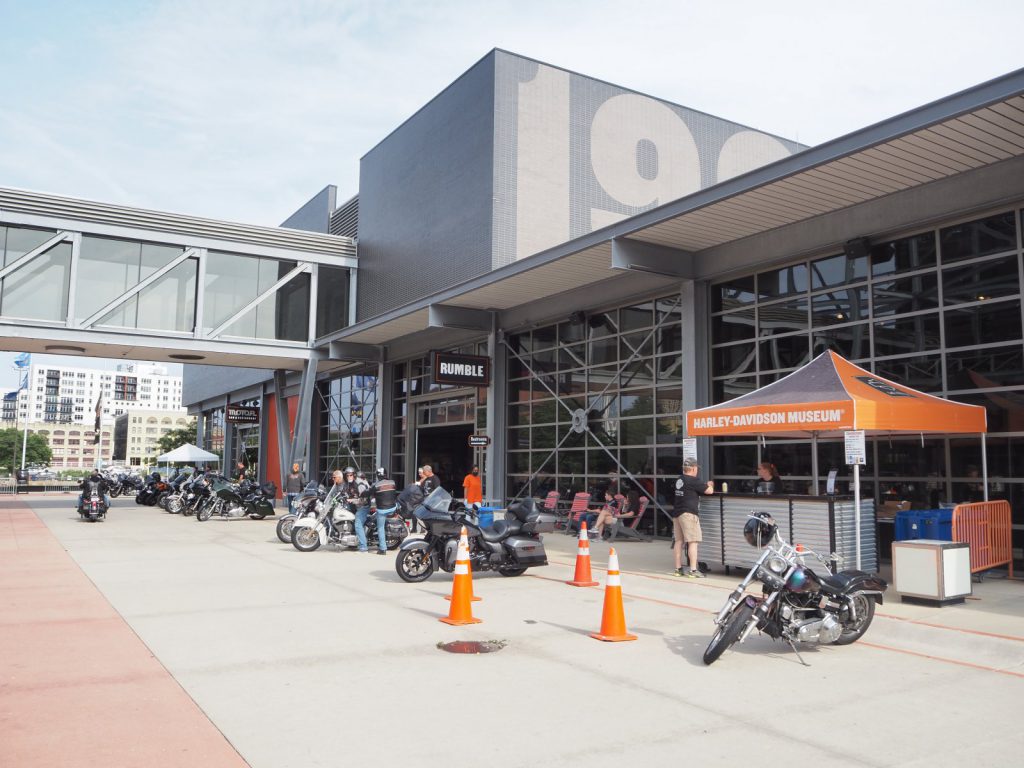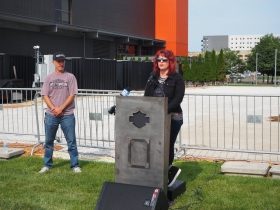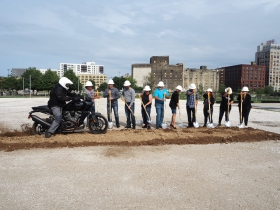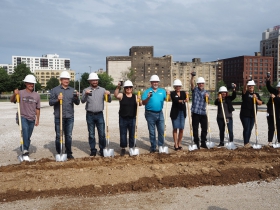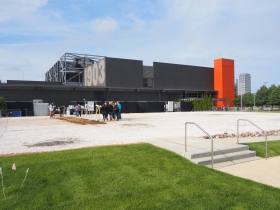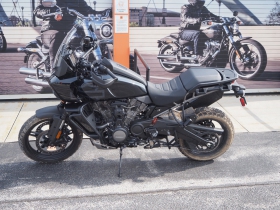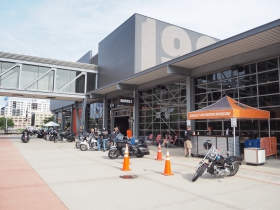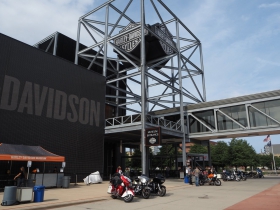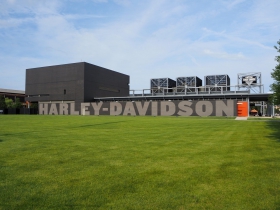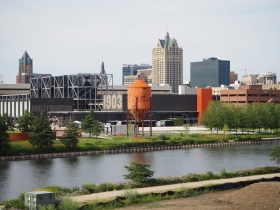Harley-Davidson Museum Worth $12 Million
But this value will soon increase. And the site has a remarkable history.
Schlitz beer may have made Milwaukee famous, but the Cream City’s most famous and widely available product is the Harley-Davidson motorcycle. The firm has retailers in 98 countries spanning the globe. So strong is the brand loyalty that the H-D logo is frequently requested by customers at tattoo parlors. The firm’s headquarters remains at 3700 W. Juneau Ave., where the first factory was built in the back yard of the home of William C. Davidson (1846-1923). His sons Walter Davidson, Sr. (1876-1942), William A. Davidson (1870-1937) and Arthur Davidson (1881-1950) founded the firm in 1903 with their neighbor, engineer William S. Harley (1880-1943). Since 1915 the company has set aside one of each model made, storing the machines along with an incredible amount of corporate memorabilia in its warehouses and other facilities. The collection of motorcycles includes the earliest known H-D vehicle, Serial Number One.
Such a burgeoning assemblage begged to be placed in a home of its own, so during the 1990s the firm hired Dr. Martin Jack Rosenblum (1946-2014), a UWM professor and poet who styled himself as The Holy Ranger, a character appealing to the motorcycle crowd, becoming a cult figure in his own right. According to his obituary:
Marty was a diehard Harley enthusiast and while working for Harley-Davidson, he was responsible for organizing the archives, motorcycles, and materials that went back to the beginning of the Motor Company. His efforts played a major role in the creation of the current Harley-Davidson Museum.
But where to locate the museum? The company wanted a high-visibility location, so the headquarters was out of the running. There were plans to place it at Schlitz Park, the site of the former brewery, but they fell through. But in the early 2000s, a home was found on 15 acres of land at the eastern end of the Menomonee River Valley, surrounded by canals on three sides, and contaminated by over a century of heavy industrial uses.
On June 1st, 2006, a groundbreaking ceremony was held, with a distinctly H-D touch. Eschewing the traditional golden shovels, the soil was broken by dirt biker Scott Parker, riding a Hog. Attendees received a small vial of the earth, with a tag attached, commemorating the event. The museum opened to the public on July 12th, 2008, and now ranks as one of the city’s top tourist attractions and event venues. At the time, the city assessor calculated the property’s value at $1,899,100 for the land and $9,000,900 for the improvements, for a total valuation of $10,900,000. Today the land is valued at the same amount, while the improvements are assessed at $10,120,600 for a total of $12,019,700.
It will soon be time for the assessor to pay another visit to the property, as a second groundbreaking was held on Thursday, July 15th, as Jeramey Jannene noted in his story for Urban Milwaukee. Once again, a motorcycle replaced the golden shovels. The new 8,200-square-foot “Garage,” is to be an event facility and replace a seasonal tent on the grounds, and will certainly increase the value of the property.
The Site in History
“Milwaukee” is sometimes translated from the Native American “Milioke” as “Gathering Place by the Water.” The Menomonee River flowed lazily to its confluence with the Milwaukee and Kinnickinnic rivers, rimmed by native plants and wild game, with abundant marshes of wild rice (“Menomin”) to provide grain. The Potawatomi tribe occupied the land by the 1700s. Other tribes to gather here at various times included the Ojibwa, Fox, Menominee, Ottawa, Sauk and Winnebago. They were displaced by white settlers in 1835. By 1850 the Milwaukee and Mississippi Railroad ran from the valley five miles west to Wauwatosa, ultimately reaching the Big Muddy at Prairie du Chien in 1857.
For over a century, the four-mile long and half-mile wide valley became the polluted heart of “The Machine Shop of the World,” with hundreds of factories employing thousands of residents in a panoply of 19th century industrial jobs.
Here, at the northeast corner of the valley, where we now find the museum, were located a number of enterprises typical of the time. One of them has a family connection to its current use.
J. S. Davidson’s “Shoddy Mill”
The Sanborn Atlas of 1894 shows a number of heavy industrial uses on the site. J. Gross & Sons and the Wisconsin Fuel Co. stored mountains of coal on the site, while the Milwaukee Lumber Company, Steinman Lumber Co. and Moe and Bentley did the same with the enormous volume of logs transported from the interior of the state. J. Rademacher did them one better, dealing in coal and wood. A. C. Beck planed the lumber at its mill, while Mueller & Sons converted scraps into boxes, with the entire third floor of its factory devoted to the manufacture of cigar boxes.
The mill’s owner, John S. Davidson (1849-1907) was the younger brother of William C. Davidson, whose three sons and William Harley were to found the motorcycle company in 1903.
By 1910 we find a new viaduct rising 22 feet above the site, with a U-shaped approach leading to the docks of the Western Line and Cement Co., organized by Orren Robertson, the son-in-law of Edward D. Holton, whose canal was right around the corner from the cement warehouse. Bentley and Company’s lumber piles averaged 12-feet to 15-feet high. Davidson’s shoddy mill was gone, with the adjacent Gross coal piles expanding to that site, at more than twice the height of their woody counterparts.
As the decades rolled on, the entire valley fell into a general disuse, with only a few firms remaining by midcentury. These tended to be rather disagreeable affairs like stockyards, slaughterhouses, and the Milwaukee Tallow Company, whose malodorous emanations were familiar to nearby residents and County Stadium visitors on humid summer nights, and much remarked upon. The Stockyard Bar and Feedlot Restaurant lasted until the late 1980’s, located right in the middle of the mess and popular with those who used knives at work, and occasionally for mischief, as a scarred bartender who worked at the establishment made abundantly clear.
The Site Today
By 1999 the Menomonee Valley Partners was incorporated to help redevelop the area, including the Harley site, raised yet another five feet to contain the contaminated soil beneath. The sheds of the city were torn down, as the factories preceding it had been decades before. HGA designed the brick-clad structure, which was once again surrounded by native plants and trails. The Menomonee Valley Partners also is now spearheading the reclamation of the stagnant and polluted Burnham Canal to the south. The valley has also drawn a number of modern factories, sandwiched between American Family Field, the Potawatomi Casino and Hotel and the Harley-Davidson Museum — three of the area’s principal attractions, which have returned the valley to its historic role as the “Gathering Place by the Water.”
The Bottom Line
-
- Name of Property: Harley-Davidson Museum
- Address: 400 W. Canal St. Milwaukee. Also known as 126 N. 6th St.
- Assessed Valuation 2020: The 661,807-square-foot (15.93 acre) lot is assessed at $1,899,100 ($2.87/s.f.) and the 110,250 square foot improvements are valued at $10,120,600 for a total assessed valuation of $12,019,700. (In 2008 the land was assessed at the same amount, while the improvements were valued at $9,000,900 for a total of $10,900,000.)
- Taxes: 2020 Tax Bill $319,187.51. Payments current on the installment plan.
- Owner: HD MILW, LLC
- Type: Commercial
- Architect: HGA in collaboration with Pentagram Architects. Harley-Davidson Museum – HGA
- Year Built: 2007
- Neighborhood: Menomonee River Valley
- Subdivision: Walkers Point
- Aldermanic District: 12th, Jose G. Perez
- Walk Score: 61 out of 100 “Somewhat Walkable” Some errands can be accomplished on foot. Score would leap if pedestrian connection over canal to east were constructed. City average: 63 out of 100
- Transit Score: 69 out of 100 “Good Transit” Many nearby public transportation options. City average: 48 out of 100
- Bike Score: 78 out of 100; “Very Bikeable.” Biking is convenient for most trips. Plus, it is flat terrain, once you cross the 6th St. Viaduct. City average: 59 out of 100
- Bridgehunter 6th Street Viaduct
- 1910 Map
- 1894 Map
- Historic Photos of Site
Photos from Garage Groundbreaking
Harley-Davidson Museum
If you think stories like this are important, become a member of Urban Milwaukee and help support real, independent journalism. Plus you get some cool added benefits.
What's It Worth?
-
Milwaukee Yacht Club Worth $2.28 Million
 Mar 27th, 2024 by Michael Horne
Mar 27th, 2024 by Michael Horne
-
Wisconsin Club Worth $5.1 Million
 Mar 17th, 2024 by Michael Horne
Mar 17th, 2024 by Michael Horne
-
Woman’s Club of Wisconsin Is Nation’s Oldest
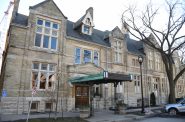 Jan 29th, 2024 by Michael Horne
Jan 29th, 2024 by Michael Horne


